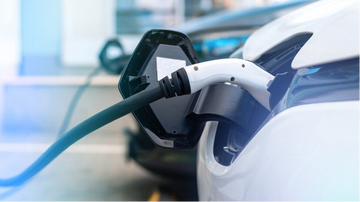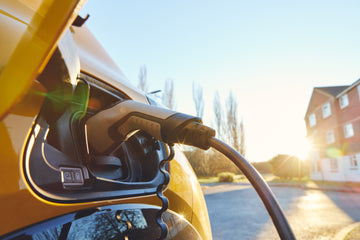
Sustainability Tips: Make your EV charging cleaner and greener
The effects of climate change and environmental degradation have devastated communities globally. Adopting a sustainable lifestyle can help reduce your carbon footprint. According to Statista, the electric vehicles (EVs) market is projected to grow by 10.07% annually from 2023 to 2028. Eco-conscious EV owners can make their EV charging cleaner and greener to reap the benefits of sustainable living. How? Read on to find out sustainability tips for EV charging.
What is EV charging?
EV charging is the process of replenishing the battery of an EV with electricity. EVs and plug-in hybrid electric vehicles have charging ports like chargeable devices and electronics. They require an EV charger to pull an electrical current from an outlet or the grid and deliver the power to the car’s battery. With the widespread adoption of electric vehicles, EV chargers and charging stations are evolving to meet the growing demand. You can recharge your EV at home and at public charging stations. Some businesses have installed dedicated EV charging equipment at their premises, allowing employees to recharge while at work.
Types of EV chargers and connectors
Most people are accustomed to refilling their gas-powered cars at one of the hundreds of thousands of gas stations before the tank runs dry. However, EV charging requires patience and the necessary hardware. Electric car models use specific types of EV chargers. So, there is no one-fits-all charger for all EVs. Here’s an overview of the three main types of electric vehicle chargers based on charging speed:
Level 1: L1 chargers use a standard 120-V AC outlet. It is best suited for home charging EVs and plug-in hybrid electric vehicles with small battery capacities. The main selling point of level 1 charging is that it doesn’t require advanced equipment. Every EV is sold with a free level 1 charge cable. However, they are slower than level 2 and 3 chargers. They restore up to 5 miles of driving range per hour. If you need to replace your level 1 charger, buy a portable EV charger compatible with J1772-equipped EVs.
Level 2: L2 chargers use dedicated charging stations or wall connectors. They are faster than L1 but slower than L3. Level 2 charging stations are universally compatible with J1772-equipped EVs. If you need to upgrade from an L1 J-plug, buy an EV level 2 charger. It is about 8 times faster than standard L1 chargers. An energy-efficient L2 charger can restore up to 12 miles/hour. You plug your EV for 8 hours to get about 100 miles of driving range. An L2 charger is perfect for home and public charging stations.
Level 3: L3 chargers use high-powered direct current (DC), restoring up to 80% of EV’s battery capacity. It is faster than L1 and L2 charging. However, most homes cannot support the power requirements of DC fast charging. Stations in urban areas and along busy highways use L3 chargers to reduce charging times. Tesla was the first to deploy level 3 charging stations under its Supercharger brand. However, Tesla EV owners are not restricted to using the Supercharger network. You can buy a Tesla J1772 adapter to connect and charge your Tesla from J1772-compatible charging points.
Top 6 tips to ensure cleaner and greener EV charging at home
Sustainable living is about reducing waste, using renewable energy, and conserving resources. It can help minimize environmental pollution, improve air and water quality, and create healthier living environments. Electric vehicles are more sustainable and eco-friendly than gas-powered cars. Eco-conscious EV owners can incorporate sustainability in their EV charging to save money and increase their contribution to global environmental protection and conservation efforts. Here are six tips to make your EV charging cleaner and greener:
-
Choose the correct EV charger.
The main concern for EV owners is selecting a compatible charger from different options on the market. Not all EV chargers are created equal. Most EVs use SAE J1772 for level 1 and 2 AC charging. You can buy a portable EV charger compatible with J1772 for your Chevrolet, Hyundai, Kia, Nissan, Toyota, BMW, Honda, Chrysler, and Jaguar. If you own a Tesla EV, then get a J1772 charging adapter for a seamless and reliable charging experience!
The best electric vehicle chargers offer robust features to enhance usability and sustainability. First, choose a plug-and-play solution to simplify plugging in the charger and connecting it to your EV. Second, look for an innovative charging station like the Wallbox EV charger with smart technology for hassle-free operation. You can leverage Wallbox’s scheduling, energy management, and real-time status update features to control and monitor EV charging remotely via a mobile app. Eco-conscious consumers use ENERGY STAR-certified products like the Electric Vehicle Level 2 Charger.
-
Invest in smart solar products.
A sustainable lifestyle is about using renewable energy and reducing dependence on fossil fuels. Switching from gas-powered vehicles to EVs is the first step towards sustainability. However, the power grid supplies electricity generated from renewable and non-renewable sources. One way to cut your EV’s carbon footprint is by harnessing solar energy. ZestyEV offers eco-friendly gadgets, including EV chargers and solar panels. You can buy the R600 solar-charged power station and install solar panels on your home’s roof. This portable solution can power household appliances and electronics, reducing your dependence on fossil fuels. Some EV chargers can power your car with electricity and solar. These solutions can decrease your carbon footprint and promote sustainable living.
-
Charge scheduling
EV charging requires more planning than refilling gas-powered cars. Understand how to schedule EV charging to enhance energy efficiency. First, protect battery life. Charge your EV to around 80% of battery capacity daily and 100% for occasional use and long trips. Second, maximize driving range in cold weather by pre-heating the vehicle while plugged into your EV charger. The heater can drain power, reducing the battery capacity and driving range. Don’t charge your EV in extreme heat. Overheating can overwork the battery thermal management system. Timing is a crucial sustainability determinant. Check with your local utility company to determine peak and off-peak periods. Then, schedule EV charging to access cleaner energy cost-effectively.
-
Leverage green energy tariffs.
Green energy tariffs are optional programs offered by utilities and approved by state public commissions. They cater to large commercial and industrial customers, allowing eligible organizations to buy bundled renewable electricity from large-scale projects. Green tariff programs use 100% renewable energy offered to buyers at the wholesale electricity market price or through a power purchase agreement (PPA). Both pricing mechanisms offer green energy at lower costs than conventional power supply channels. Some organizations provide green energy tariffs with cost benefits to EV owners who use home charging solutions. They offer lower rates at specific periods with low energy demands.
-
Leverage smart charging features.
Smart EV chargers allow you to intelligently control, manage, and adjust mission-critical aspects of electric vehicle charging. They leverage data, advanced algorithms, and analytics to enhance energy efficiency. First, real-time data is exchanged between EVs, EV chargers, charging point operators, and the power supplier. Then, algorithms and analytics crunch the data to provide tailored charging experiences.
Smart EV charging considers several factors, including your EV's power capacity, charging point availability in nearby stations, and energy costs. The best EV chargers, like Autel Maxi Charger Home, offer intelligent control features to help users make informed sustainability decisions. You can use the Autel Charge mobile app to track, manage, schedule, and optimize your charging sessions. Buy the Autel Maxi Charger from reliable online stores like ZestyEV to capitalize on off-peak electricity rates.
-
Vehicle-to-grid electric vehicle charging
Electric vehicle charging is a fast-evolving sector. One of the latest trends is vehicle-to-grid (V2G) EV charging, which helps EV owners manage energy usage. V2G is a sustainable technology that enables EVs to push back electricity from their battery packs to the grid. It powers bi-directional charging. You can leverage this sustainable technology to recharge your EV batteries with electricity generated from renewable sources. Then, your EV will export surplus energy later to stabilize the power grid. This approach promotes the use of renewable energy and enhances sustainability.
Conclusion
As an eco-conscious EV owner, adopt a sustainable lifestyle to contribute to the global fight against environmental pollution and protect Mother Earth. Make your EV charging cleaner and greener by choosing the correct charger, investing in solar panels, and optimizing charging schedules. You can also leverage green energy tariffs, smart charging features, and V2G to enhance sustainability. Ensure you buy your EV chargers, charging stations, and solar panels from an eco-conscious store like ZestyEV.
- Climate Change,
- Eco-Friendly Living,
- Eco-Friendly Transportation,
- Electric Vehicles,
- Energy Bill Savings,
- Energy Efficiency,
- Energy Independence,
- EV Charging,
- Green Energy,
- Greenhouse Gas Reduction,
- Home Solar Systems,
- Low Maintenance Energy,
- Renewable Energy,
- Renewable Energy Incentives,
- Smart Technology,
- Solar Energy Benefits,
- Solar Investment Returns,
- Solar Power,
- Sustainable Home Solutions,
- Sustainable Living




